DIY air heat exchanger for a chimney: manufacturing examples and tips from masters
The productivity of a boiler, heating or sauna stove can be increased by installing a simple and at the same time effective device, a heat exchanger, on the pipe. However, for its productive work, you need to know the design features and rules of manufacturing the device. Do you agree?
We will tell you how to make a heat exchanger on a chimney with your own hands. We list which modifications are suitable for self-assembly, explain how the air model differs from the water model. Based on our recommendations, you can significantly increase the heat transfer of heating units.
The content of the article:
The principle of operation of the air heat exchanger
The main purpose of the heat exchanger is to transfer energy from the combustion products in the chimney to the coolant, which is water or air. Heat exchangers installed in chimneys (this applies to water modifications) are often called economizers.
These devices collect and transfer heat to the room, which simply goes into the atmosphere, due to which the thermal energy generated by the furnace is used to the maximum. In addition to ordinary tap water, other liquids are sometimes used - oil or “non-freezing”.
In this regard, all devices are divided into two large categories:
- air;
- liquid (water).
The choice of one or another type depends on several factors. The most important of them are the configuration and material of the chimney, as well as the characteristics of the device itself.
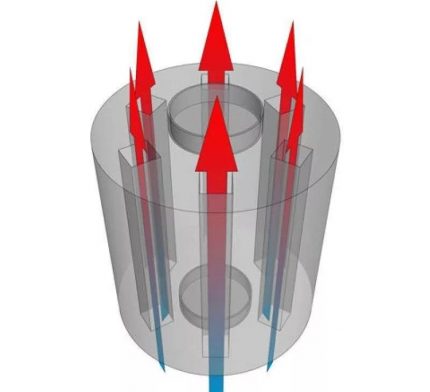
Let's see how the air model works. The design of the device is simple: a robust housing with a partitioned interior. The role of the partitions is played by plates or tubes, the main function of which is to slow down the movement of heated gases and direct heat to the right channel.
Some partitions (flaps) are not soldered, but made movable.By pushing / pulling out the metal plates, the traction force can be adjusted, thereby reducing or increasing the performance of the heater.
Air heat exchangers are called convectors, as the principle of convection is the basis of their work. Cold air from the room enters the device, where its temperature rises due to exposure to hot flue gases. In the heated state, it moves further through another hole - back to the room or to the heating system.
Types of chimney devices
Among airborne varieties, a tubular heat exchanger is considered a traditional model for self-manufacturing, although there are many other options.
Consider the main types that are relevant for installation on a chimney of long burning furnaces, small-sized bourgeois, furnaces for development. The heat that they convert from the energy of the combustion products is called dry.
If you imagine schematically the inside of the devices, then it can have the following variations.
Horizontal or vertical pipes welded to the furnace body. Vertical positioning is more efficient as air passes through channels better. The material of manufacture is steel.
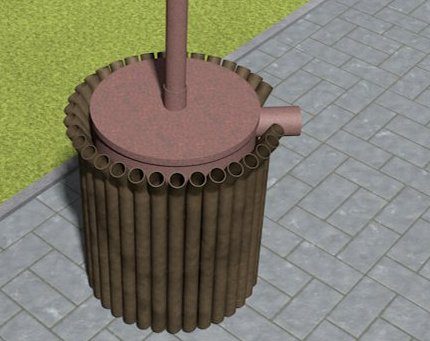
A pipe entwined around the firebox. For good heat transfer, 2-3 turns are enough, which are better to slightly expand to increase the heating area.
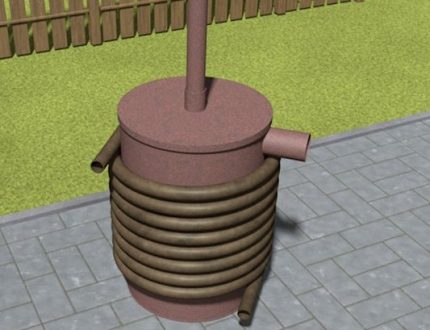
Partitions inside the case. A peculiar labyrinth is made up of metal plates mounted vertically. The optimum thickness of parts is from 6 mm to 8 mm.
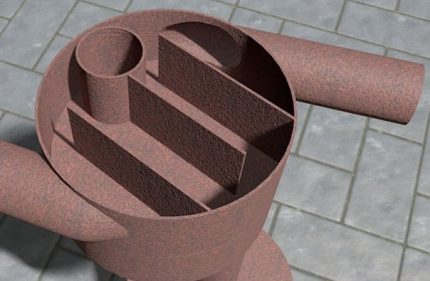
Pipes passing through the firebox.

With vertically arranged channels, the air movement is more intense, therefore, the productivity of the device is increased. But in some cases, devices with horizontally located pipes or with partitions are appropriate. Each of these models is suitable for self-manufacturing, if you have welding skills.
Which material is better?
When installing the heat exchanger, metal parts are used - galvanized sheets, gas cylinders, pipes of various diameters, cast-iron billets, etc. Cast iron is not recommended because it is brittle and heavy compared to steel, which makes it difficult to mount it on a chimney.
The best option is austenitic steel. The stainless steel easily transfers thermal differences, is steady against mechanical damages, gives in to independent processing and welding.
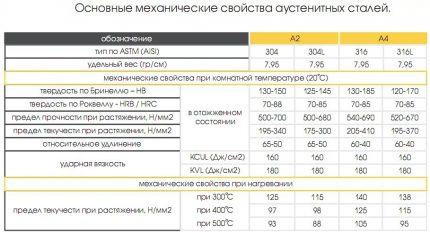
Galvanized steel is inferior to alloyed or austenitic, as it is not intended for heating. High temperature conditions lead to the release of zinc oxides that are harmful to health, so if you plan to increase the temperature in the chimney to + 419.5 ºС, galvanization should be abandoned. It is better to purchase expensive but safe material.
DIY manufacturing options
We offer several simple projects for independent production, which, if desired, can be made of metal parts using welding and power tools.
Overview of the gas cylinder heat exchanger
If you install a homemade device on a potbelly stove, the heating efficiency in the room will increase by 30-40%. The smaller the garage or workshop, the higher the productivity of the device.
We suggest considering an option that is ideal for small stoves of the “potbelly stove” type, which are actively used for heating garages.
In general, a rather neat and efficient heat exchanger for a furnace heating a small room is obtained from a gas cylinder. To further increase the efficiency of heating without a fundamental change in design, fans can be installed on the pipes, and the number of pipes can be increased to 4-5.
Photo review of economizer Feringer
As a model for the manufacture can be factory models of popular manufacturers. For example, the Feringer company, known for the production of furnaces, offers ready-made chimneys, which in essence are heat exchangers.
Consider models of simple construction. All the details of which they consist can be done independently.
The main idea that can be taken from advanced Feringer models is the use of four pipes instead of one. If the stove is already installed in the garage or utility room, we remove part of the chimney, install a four-pipe economizer instead, and the room temperature immediately rises by several degrees.
Homemade air convector
The proposed model is completely made of steel parts. This is a heat exchanger, which is approximately 1.5 times larger in size than the chimney.
It is a drum with tubes perpendicular chimney flue. Stainless steel was not chosen for nothing - it easily tolerates high temperatures, is well cleaned and does not burn out.
To work, you will need:
- steel pipe with a diameter of 30 mm (for the manufacture of 8 identical sections);
- pipe fragment 50 mm (for the central channel);
- 2 mm thick metal sheet (for manufacturing 2 round plates and a casing);
- 20 l paint can (for the chimney adapter).
It is also necessary to prepare a tool for cutting and welding metal.
This is one of the best chimney air heat exchanger options. garage stoves or utility room. The design can be simplified by welding metal partitions instead of tubes, but the principle of operation will remain the same: the heated air from the chimney will be an additional source of heat for the room.
Manufacturing process directly chimney for stove stove The article recommended by us is devoted. It is better to equip the chimney immediately during manufacture with a heat exchanger.
Conclusions and useful video on the topic
Several video recommendations will help to better understand the device and the principle of operation of a home-made heat exchanger.
Video # 1. Tips for making a model from pipes:
Video # 2. Model from aluminum corrugated board:
Video # 3. A simple option from improvised materials:
As you can see, to increase the efficiency of the stove in the garage, utility room or bathhouse, you can not spend money on expensive appliances, but make an effective device with your own hands. For work, you will need metal working skills and an approximate assembly scheme.
Do you know how to make an original version of a heat exchanger for installation on a chimney with your own hands? Do you have any questions while familiarizing yourself with the information provided or is there useful information for visitors to the site and us? Please write comments in the block below.

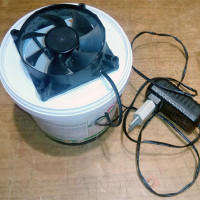 DIY air humidifier: instrument options and manufacturing instructions
DIY air humidifier: instrument options and manufacturing instructions  How to make a fan yourself: the best options for homemade
How to make a fan yourself: the best options for homemade  How to make a non-return valve for ventilation with your own hands: instruction on the construction of a homemade product
How to make a non-return valve for ventilation with your own hands: instruction on the construction of a homemade product 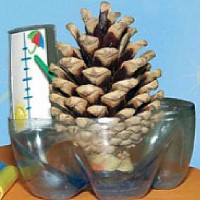 Do-it-yourself air humidity meter: assembly instructions for the hygrometer
Do-it-yourself air humidity meter: assembly instructions for the hygrometer  How to clean the ventilation in the apartment with your own hands: suitable tools and work procedures
How to clean the ventilation in the apartment with your own hands: suitable tools and work procedures 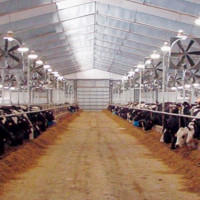 Do-it-yourself ventilation of the barn: types of systems, air exchange rates + system arrangement
Do-it-yourself ventilation of the barn: types of systems, air exchange rates + system arrangement  How much does it cost to connect gas to a private house: the price of organizing gas supply
How much does it cost to connect gas to a private house: the price of organizing gas supply  The best washing machines with dryer: model rating and customer tips
The best washing machines with dryer: model rating and customer tips  What is the color temperature of light and the nuances of choosing the temperature of the lamps to suit your needs
What is the color temperature of light and the nuances of choosing the temperature of the lamps to suit your needs  Replacement of a geyser in an apartment: replacement paperwork + basic norms and requirements
Replacement of a geyser in an apartment: replacement paperwork + basic norms and requirements